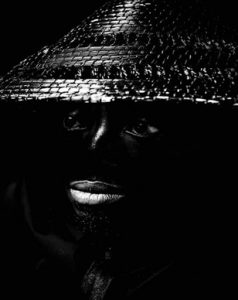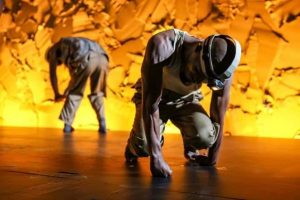A Hole in Waiting: Delineating Embodiment into Performance
(listen to the selection, read by Diane R. Wiener)
As someone who grew up being gazed upon, I seem to have focused my gaze on the mines, the effects of imperialism and apartheid from a metaphorical perspective. This has informed my practice to engage in activism on issues of identity, body politics and raising the profile of people with functional diversity.
In this essay, I will trace my process of creating A Hole in Waiting, while documenting an embodied approach to my personal theatre-making process. A Hole in Waiting relates the neglect of the concept of the mines in South Africa to personal lived experience. The project directly acknowledges the graves of thousands of people as a result of an aggressive drilling system of the environment where I was born during the collapse of apartheid. I use the word “embodied” to describe creating and learning in acknowledgement of my body as a whole experiential being in motion, both embedded and embedding the personal.
The term “apartheid” has a significant legacy that is directly linked with the spatial landscape of South Africa and racial segregation. As a theatre-maker, I contemplate much around the apartheid system as a political and social hole that has left a mark both emotionally and physically, and which poses fundamental questions in our bodies. In the post-apartheid theatre-making context, I have observed that the body is the site where apartheid and other forms of violence are imprinted. This understanding suggests the body as a corporeal being accessed by theatre-makers to create performances that respond to the colonial design’s effects and influences.
I usually begin my projects by conceptualizing with an understanding of post-apartheid: the body is immersed with socio-political factors that are systemically violent, resulting from the discourse emanating from the country’s history. Growing up in an environment that was and still is surrounded by aggressive drillings of the land, I am triggered to imagine questions that form a significant part in the conceptualization of A Hole in Waiting:
After the act of violence in and to the ground, where do we go to reconstruct our being-in-our-bodies? Is living in the aftermath of violence an emergence of further and new forms of collective trauma? Who is going to heal ancestral traumas that keep finding living bodies?
Thus, A Hole in Waiting directly examines the position of the body in the postcolonial conditions of the mining industry in South Africa. One of the main questions that should be posed during the post-colony is: “where and how do we begin to restore and reclaim ancestors who have traveled kilometers beyond the normal grave ritual practices to die and evoke deadly spiritual warfare?”
Nancy Krieger, a scholar and researcher on embodiment, states that bodies tell stories about—and cannot be studied divorced from—the conditions of our existence; bodies tell stories that often—but not always—match people’s stated accounts; and bodies tell stories that people cannot or will not tell, either because they are unable, forbidden, or choose not to tell. The paradigm in which I contextualise this essay is of the body being interconnected with the land.
The land is not immaterial. It has a relation with the body. Consequently, the body houses the memory. The struggle of memory against forgetting details remains fragmented and archived in the body. And in A Hole in Waiting, underneath an imperial dug out hole, a child journeys into the fertile imaginations of the land that entrapped miners.
I indirectly relate stories/happenings/rituals my grandfather, father, and miners who surrounded me were engaging in when I was growing up. For instance, the intensity or viscera of their “eyes.” These same eyes have now been embodied by some of my peers and cousins who are now miners. If I were to describe the eyes, I would fail dismally. But I can assure one that the eyes had swallowed so much that was supposed to have been left as sacred in the land.
In Africa’s Hidden History: The Reptilian Agenda, the renowned late traditional shaman, author, artist, and philosopher, Vusamazulu Credo Mutwa, relates one of the strangest stories found everywhere in African shamanic secret societies and other places containing ancient knowledge and wisdom. Mutwa records that originally human beings believed that God was underground—that she was a very great mother who dwelt under the earth because they saw all the green things growing from under the earth. The grass came from below the ground, the trees grew from below the ground, and the people believed that the dead people also go underground. But when the Chitauri turned humans’ eyes towards the sky, people started believing that God is in the sky and that those who die from this earth don’t go underground but go up into the sky. Mutwa records the meaning of the word Chitauri as “the dictators, they who tell us the law.” In other words, “they who tell us, secretly, what we are to do.” Mutwa further records that the Chitauri forced human beings to mine into the earth and told human beings that they have been wrong in believing that God dwelt under the earth.
Below is a self-portraiture image that attempts to arrive at the idea of the eyes swallowing underground sacredness. I call this image “Bury My Eyes First.” The image is also a response to seeing beyond what has been earthly and spiritually other-worldly.

Photographer: Zivanai Matangi
The use of my body as a site of performance is to reconstruct contemporary epistemologies around the notion of “disability.” A post-colonial thinker, Mbembe, remarks, “there is, truly, no memory except in the body of commands and demands that the past not only transmits to us but also requires us to contemplate.” I believe that I have been born in a body that has been part of an archive way before I was born. A body that has been bestowed with a duty to heal unsettling stories of violence that are embraced but missing in the archive of postcolonial violence.
This comes with the oral storytelling of my surname Ratladi and its origins. Ratladi is a Sepedi word that means “the father of thunder.” Legend has it that it is derived from the duty one of my great-great grandfathers had in the northern parts of South Africa. It is said that my great-great grandfather used to climb up the mountain to call on thunder to strike the Anglo-Boers during the 1800s colonial wars when they approached.
This ritual positioned him as a griot and a mediator. In my projects, the body is cast as a mediator between the act of violence onto the bellies of the land and the dead. The embodied corporeality that miners bring back to the land is a collective nightmare that has created patterns that I constantly respond to as a theatre-maker.

Photographer: Zivanai Matangi
A HOLE IN WAITING is in partnership with The Centre of The Less Good Idea in Johannesburg (South Africa)), a space for artistic creation founded by the artist William Kentridge, and Teatre Lliure in Barcelona (Spain) for the Creative exchange residencies in the 20/21/22 season.
References:
Krieger, N. 2005. Embodiment: A Conceptual Glossary for Epidemiology. Journal of Epidemiology and Community Health (1979-), 59(5), 350-355. Retrieved September 1, 2021, from http://www.jstor.org/stable/25570710.
MBEMBE, A. 2008. What is postcolonial thinking? An Interview with Achille Mbembe. Eurozine, 2008\01\09 [Online]. Interviewed by O. Mongin, N. Lempereur and J-L. Schlegel. Original in French translated by J. Fletcher. First published in Esprit 12/2006. Available: http://www.eurozine.com/articles/2008\01\09\mbembe\en.html [2011, December 20].
Mutwa, C. Africa’s Hidden History: The Reptilian Agenda.
“Disability Futures in the Arts” is supported by the Canada Council for the Arts/Conseil des arts du Canada.
Back to Top of Page | Back to Disability Futures in the Arts | Back to Volume 15, Issue 4 – Winter 2021
About the Author
Calvin Seretle Ratladi is a trained interdisciplinary artist who works as a freelance producer, director, writer, actor/performer, choreographer, fieldworker, dramaturg, curator, and arts administrator for various companies, organisations, and institutions including William Kentridge’s The Centre for the Less Good Idea. Ratladi is well-known for his adaptability and advocacy of identity, politics of the body in post-coloniality, and giving voice to people living with disabilities. He is currently pursuing his Master’s Degree in performance-making, employing praxis action research to investigate embodiment within a South African performance-making context.